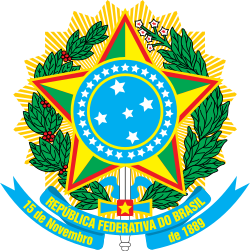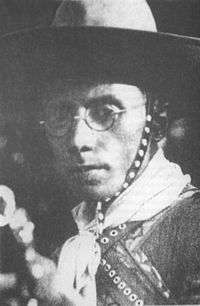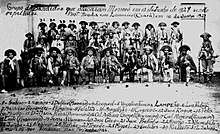Cangaço
Cangaço (Portuguese pronunciation: [kɐ̃ˈɡasu]) was the banditism phenomenon of Northeast Brazil in the late 19th and early 20th centuries. This region of Brazil is known for its aridness and hard way of life, and in a form of "social banditry" against the government, many men and women decided to become nomadic bandits, roaming the hinterlands seeking money, food and revenge.
Part of a series on the |
|---|
| History of Brazil |
 |
|
|
|
|
|
|
|
|
|
Origin of the word
By 1834, the term cangaceiro was already used to refer to bands of poor peasants who inhabited the northeastern deserts, wearing leather clothing and hats, carrying carbines, revolvers, shotguns, and the long narrow knife known as the peixeira.
"Cangaceiro" was a pejorative expression, meaning a person who could not adapt himself to the coastal lifestyle.
By this time in that region, there were two main groups of loosely organized armed outlaws: the jagunços, mercenaries who worked for whoever paid their price, usually land-owners who wanted to protect or expand their territorial limits and also deal with farm workers; and the cangaceiros, "social bandits", who had some level of support from the poorest population: the bandits sustained some beneficial behaviors such as acts of charity, buying of goods for higher prices and giving free parties ("bailes"), and the population provided shelter and information which helped them escape from police forces, known as volantes, sent by the government to stop them. The poorer inhabitants of the backlands of the Brazilian Northeast were generally badly treated by the paramilitary police, and often preferred the presence of cangaçeiro bands in their settlements.[1]
Lampião

Photo by Benjamin A. Botto.
The most famous cangaceiro of them all, the one who is often associated with the whole history of the cangaço, was a man called Virgulino Ferreira da Silva, also known as "Lampião" ("Oil Lamp", because, according to his fellows, he could shoot so quickly that he could illuminate the place). He began when he was just a boy, amongst vendetta plots of the Pereira and Nogueira-Carvalho families. When his parents were killed because of these disputes, some of his brothers ran away, but Antônio, Livino, and Ezequiel followed Virgulino into the cangaço.[2]
Seen as a mixture of hero and bandit, Lampião became one of the most representative icons of Brazil.
Wandering around Santa Brígida, in the state of Bahia, he met Maria Alia da Silva (a.k.a. Maria de Déia), wife of shoemaker Zé de Nenê. Later she would be better known as Mrs. Lampião, Maria Bonita (literally "Pretty Maria").
Lampião was killed by the police in 1938, in a region between the state limits of Bahia and Alagoas, when an informer, Pedro de Cândida gave away their location to the police. A massive offensive led to bloodshed, and the eleven of the band was killed: Lampião, Maria Bonita, Luís Pedro, Mergulhão, Enedina, Elétrico, Quinta-Feira, Moeda, Alecrim, Colchete and Macela.[3]
Coiteiros
Coiteiros were people who helped the cangaceiros, giving them shelter and food. They did this for many reasons – they could be relatives of a cangaceiro, friends, ex-neighbours, or simply had some interest in their power, or they were afraid of them.
Volantes and monkeys
The volantes were a small and special band of troops—around twenty to sixty—from every state of the Brazilian federation, formed by the government Law-Enforcement agencies sent to seek and destroy the cangaceiros. The cangaceiros often referred to them as "monkeys", because of their brown uniforms and their willingness to obey their orders. Some of them carried modern Hotchkiss machine guns, weapons that the cangaceiros quickly learned to fear—but were always willing to steal for their own use.
Cangaceiro style
The cangaceiros had very specific notions of how to behave and dress. First of all, most of them knew how to sew quite well. Living in the desert lands of the northeast of Brazil, they had to survive amidst spiky dry bushes. Despite the heat during the day, the cangaceiros preferred to wear leather clothing, embellished with all kinds of coloured ribbons and metal pieces.[4]
They also used leather gloves with coins and other pieces of metal sewn onto them, almost like armour.
Because of the heat and the absence of water some cangaceiros -–especially Lampião-– wore French perfume. They often stole it from rich people's houses, but usually paid for it if obtained from small shopkeepers, and used it in large quantities.[5]
Cangaceiro weapons
The weapons of the Cangaceiros were mostly revolvers, shotguns, and the famous "pára belo". It is claimed that like 'macaco' (monkey), 'belo' (beautiful) was another slang term for the policemen. Hence, pistols and Winchester-like rifles were called "pára belo" (belo stopper). However, the name seems to be actually a derivation of the Latin expression para bellum, which means "prepare for war" and was used to refer to the then official sidearm used by the Brazilian governmental troops and by some of the law enforcement soldiers, the Luger pistol, which was produced by the German arms maker DWM.[6]
They also made famous a thin, long, and very sharp knife nicknamed a "peixeira", a fish-filleting knife, used mostly to torture or cut the throats of their victims. The knife was also used in a very specific way to kill quickly; the blade was stabbed downwards between the neck and collarbone, due to its length the blade would cause instantly lethal damage to major blood vessels and the heart.
Famous cangaceiros
- Adolfo Meia-Noite
- Antônio Silvino
- Cabeleira
- Corisco
- Diogo da Rocha Figueira aka "Dioguinho" (in São Paulo)
- Jesuíno Brilhante
- Lampião
- Lucas da Feira
- Maria Bonita
- Sinhô Pereira
The Cangaço in film
- O Cangaceiro, Lima Barreto 1953 (original score by Riz Ortolani)
- A Morte Comanda o Cangaço, Walter Guimarães Motta 1961
- Deus e o Diabo na Terra do Sol, English title: "White God, Black Devil" Glauber Rocha 1963
- O Dragão da Maldade Contra o Santo Guerreiro, Glauber Rocha 1968
- Baile Perfumado, Paulo Caldas and Lírio Ferreira 1997
- O Auto Da Compadecida, English title: "A God's Will" Guel Arreas 2000
- O Matador, Marcelo Galvão 2017
See also
- History of Brazil
- Land reform
- Landless Workers' Movement
- The epic cycle of the cangaceiros in popular poetry from northeastern Brazil - thesis by Ronald Daus, Free University of Berlin: see bibliography.
References
- Singelmann, pp. 67-68, 75
- Chandler, p. 3
- Chandler, pp. 220-230
- Chandler, p. 5
- Chandler, pp. 95-99
- Chandler, pp. 71, 183
| Wikimedia Commons has media related to Cangaço. |
Bibliography
- Chandler, Billy Jaynes (1978). The Bandit King: Lampião of Brazil. Texas A&M University Press. ISBN 0-89096-194-8.
- Singelmann, Peter (1975) Political Structure and Social Banditry in Northeast Brazil. Journal of Latin American Studies, Vol. 7, No. 1.
